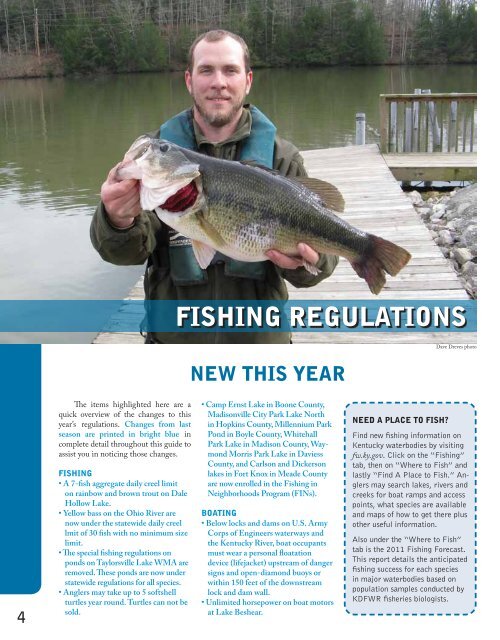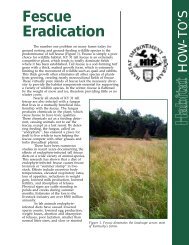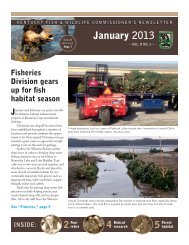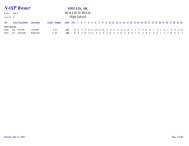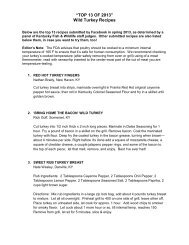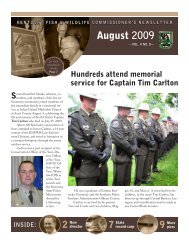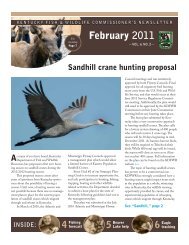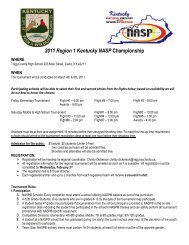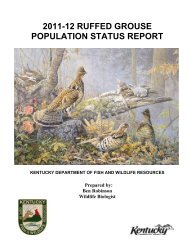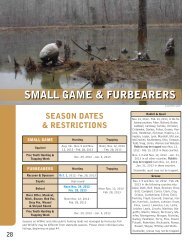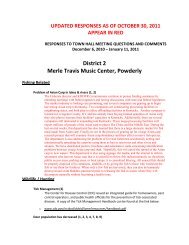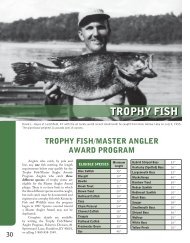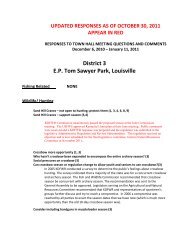Fishing Regulations - Kentucky Department of Fish and Wildlife ...
Fishing Regulations - Kentucky Department of Fish and Wildlife ...
Fishing Regulations - Kentucky Department of Fish and Wildlife ...
You also want an ePaper? Increase the reach of your titles
YUMPU automatically turns print PDFs into web optimized ePapers that Google loves.
FISHING REGULATIONS<br />
4<br />
The items highlighted here are a<br />
quick overview <strong>of</strong> the changes to this<br />
year’s regulations. Changes from last<br />
season are printed in bright blue in<br />
complete detail throughout this guide to<br />
assist you in noticing those changes.<br />
FISHING<br />
• A 7-fish aggregate daily creel limit<br />
on rainbow <strong>and</strong> brown trout on Dale<br />
Hollow Lake.<br />
• Yellow bass on the Ohio River are<br />
now under the statewide daily creel<br />
lmit <strong>of</strong> 30 fish with no minimum size<br />
limit.<br />
• The special fishing regulations on<br />
ponds on Taylorsville Lake WMA are<br />
removed. These ponds are now under<br />
statewide regulations for all species.<br />
• Anglers may take up to 5 s<strong>of</strong>tshell<br />
turtles year round. Turtles can not be<br />
sold.<br />
FISHING REGULATIONS<br />
NEW THIS YEAR<br />
• Camp Ernst Lake in Boone County,<br />
Madisonville City Park Lake North<br />
in Hopkins County, Millennium Park<br />
Pond in Boyle County, Whitehall<br />
Park Lake in Madison County, Waymond<br />
Morris Park Lake in Daviess<br />
County, <strong>and</strong> Carlson <strong>and</strong> Dickerson<br />
lakes in Fort Knox in Meade County<br />
are now enrolled in the <strong><strong>Fish</strong>ing</strong> in<br />
Neighborhoods Program (FINs).<br />
BOATING<br />
• Below locks <strong>and</strong> dams on U.S. Army<br />
Corps <strong>of</strong> Engineers waterways <strong>and</strong><br />
the <strong>Kentucky</strong> River, boat occupants<br />
must wear a personal floatation<br />
device (lifejacket) upstream <strong>of</strong> danger<br />
signs <strong>and</strong> open-diamond buoys or<br />
within 150 feet <strong>of</strong> the downstream<br />
lock <strong>and</strong> dam wall.<br />
• Unlimited horsepower on boat motors<br />
at Lake Beshear.<br />
Dave Dreves photo<br />
NEED A PLACE TO FISH?<br />
Find new fishing information on<br />
<strong>Kentucky</strong> waterbodies by visiting<br />
fw.ky.gov. Click on the “<strong><strong>Fish</strong>ing</strong>”<br />
tab, then on “Where to <strong>Fish</strong>” <strong>and</strong><br />
lastly “Find A Place to <strong>Fish</strong>.” Anglers<br />
may search lakes, rivers <strong>and</strong><br />
creeks for boat ramps <strong>and</strong> access<br />
points, what species are available<br />
<strong>and</strong> maps <strong>of</strong> how to get there plus<br />
other useful information.<br />
Also under the “Where to <strong>Fish</strong>”<br />
tab is the 2011 <strong><strong>Fish</strong>ing</strong> Forecast.<br />
This report details the anticipated<br />
fishing success for each species<br />
in major waterbodies based on<br />
population samples conducted by<br />
KDFWR fisheries biologists.
BLACK BASS<br />
STATEWIDE REGULATIONS<br />
Some waterbodies have different size <strong>and</strong> creel limits, please refer to the “Special <strong><strong>Fish</strong>ing</strong> <strong>Regulations</strong>” section for more details.<br />
SPORT FISH SPECIES Daily Limit Possession Limit Minimum Size Limit<br />
Largemouth Bass 6* 12* 12”<br />
Smallmouth Bass 6* 12* 12”<br />
<strong>Kentucky</strong> (Spotted) Bass 6* 12* none<br />
Coosa Bass 6* 12* none<br />
Rock Bass 15 30 none<br />
Redear Sunfish 20 40 none<br />
Walleye, Sauger <strong>and</strong> their Hybrids 6* 12*<br />
15” on walleye <strong>and</strong><br />
hybrids; none on sauger<br />
Muskellunge 1 2 30”<br />
Chain Pickerel 5 10 none<br />
Northern Pike none none none<br />
White & Hybrid Striped Bass 15** 30** none**<br />
Striped Bass 5 10 15”<br />
Yellow Bass 30 60 none<br />
Crappie (Black & White) 30* 60* none<br />
Rainbow Trout<br />
none<br />
Daily limit 8, only 3 may be brown trout***<br />
Brown Trout 12”<br />
Brook Trout Catch <strong>and</strong> release only<br />
* Singly or combined; a total <strong>of</strong> these species<br />
** No more than 5 fish in the daily creel limit may be more than 15 inches long.<br />
*** Possession limit is double the daily creel limit for these species.<br />
<strong>Fish</strong> not included in this list are considered rough fish. There are no size or creel limits for rough fish, unless special regulations apply.<br />
For daily creel <strong>and</strong> fishing license purposes, one fishing day equals one calendar day.<br />
STATEWIDE SIZE AND CREEL<br />
LIMITS (301 KAR 1:060, 1:201; KRS<br />
150.010)<br />
<strong><strong>Fish</strong>ing</strong> season is open year-round<br />
in <strong>Kentucky</strong>, except on waterfowl refuges<br />
<strong>and</strong> as otherwise noted in this guide.<br />
Statewide size <strong>and</strong> creel limits apply to<br />
all <strong>Kentucky</strong> waters, public <strong>and</strong> private,<br />
except some waters have different limits<br />
(see, “Special <strong><strong>Fish</strong>ing</strong> <strong>Regulations</strong>”.) The<br />
<strong>Kentucky</strong> Trout Waters information is<br />
now incorporated into this guide. Please<br />
see page 26.<br />
Did you know?<br />
Camping is prohibited on KDFWR owned or managed lakes.<br />
Q: How is a daily creel limit<br />
different than a possession limit?<br />
A: The daily creel limit is the<br />
number <strong>of</strong> a particular sport fish<br />
species you may keep in one day’s<br />
fishing. A possession limit is two<br />
times the daily creel limit for all fish<br />
species with a daily creel limit <strong>and</strong><br />
excludes processed fish.<br />
MEASURING FISH<br />
(301 KAR 1:201)<br />
Measure all fish from the tip <strong>of</strong> the<br />
lower jaw (closed) to the tip <strong>of</strong> the tail<br />
with fish laid flat on rule with tail lobes<br />
squeezed together. Undersized fish must<br />
be returned immediately to the waters<br />
from which they were taken in the best<br />
possible physical condition.<br />
length<br />
Squeezed tail<br />
FISHING REGULATIONS<br />
5
FISHING REGULATIONS<br />
6<br />
SPECIAL FISHING REGULATIONS<br />
(301 KAR 1:080, 1:180, 1:201, 2:222<br />
4:100, 4:200E; KRS 150.010, 150.025)<br />
SPECIAL REGULATION WATERS<br />
LISTED ALPHABETICALLY<br />
The public waters listed below have<br />
different size <strong>and</strong>/or creel limits than<br />
statewide regulations allow. Statewide<br />
size <strong>and</strong> creel limits apply unless otherwise<br />
mentioned below. Special boating<br />
regulations are listed in the Boating section<br />
<strong>of</strong> this guide.<br />
Some privately owned waters may<br />
have special size <strong>and</strong> creel limits as posted<br />
by signs.<br />
FINs LAKES:<br />
Lakes in the <strong><strong>Fish</strong>ing</strong> In Neighborhoods<br />
(FINs) program now have uniform<br />
regulations for daily creel <strong>and</strong> size<br />
limits:<br />
• Rainbow Trout: 5-fish daily limit.<br />
• Catfish: 4-fish daily limit.<br />
• Sunfish: 15-fish daily limit.<br />
• Largemouth Bass: 15-inch minimum<br />
size limit, 1 fish daily limit.<br />
The follwing FINs lakes are now<br />
under these special regulations:<br />
Anderson County Community<br />
Park Lake (Anderson County), Bloomfield<br />
Park Lake (Nelson County), Bob<br />
Noble Park Lake (McCracken County),<br />
Brickyard Pond (Knox County), Camp<br />
Ernst Lake (Boone County), Carlson<br />
<strong>and</strong> Dickerson Lakes (Ft. Knox, Meade<br />
County), Cherokee Park Lake ( Jefferson<br />
County), Easy Walker Park Pond<br />
(Montgomery County), <strong>Fish</strong>erman’s<br />
Park Lakes ( Jefferson County), Kingdom<br />
Come State Park Lake (Harlan County),<br />
Lake Mingo ( Jessamine County),<br />
Lake Pollywog (Grant County), Lower<br />
Sportman’s Lake (Franklin County),<br />
Lusby Lake (Scott County), Madisonville<br />
City Park Lake North (Hopkins<br />
County), Martin County Lake (Martin<br />
County), Middleton Mills Long<br />
Pond <strong>and</strong> Shelterhouse Ponds (Kenton<br />
County), Mike Miller Park Lake (Marshall<br />
County), Miles Park Lakes ( Jefferson<br />
County), Millennium Park Pond<br />
(Boyle County), Panther Creek Park<br />
Lake, (Daviess County), Prisoner’s Lake<br />
(Kenton County), Scott County Park<br />
Lake (Scott County), Southgate Lake<br />
(Campbell County), Stein Community<br />
Park Lake (Campbell County), Three<br />
Springs Lake (Warren County), Tom<br />
Wallace Park Lake ( Jefferson County),<br />
Upper Sportsman’s Lake (Franklin<br />
County), Watterson Park Lake ( Jefferson<br />
County), Waverly Park Lake ( Jefferson<br />
County), Waymond Morris Park<br />
Lake (Daviess County), Whitehall Park<br />
Lake (Madison County), Yellow Creek<br />
Park Lake (Daviess County)<br />
A.J. JOLLY LAKE<br />
Campbell County<br />
No harvest <strong>of</strong> flathead catfish.<br />
BARK CAMP CREEK<br />
Whitley County<br />
All trout caught from October 1<br />
through March 31 must be immediately<br />
released <strong>and</strong> only artificial baits shall be<br />
used during this period.<br />
BARKLEY, KENTUCKY LAKES<br />
(<strong>and</strong> their connecting canal)<br />
• Crappie: 10-inch minimum size limit,<br />
20 fish daily creel limit.<br />
• Largemouth <strong>and</strong> Smallmouth Bass:<br />
15-inch minimum size limit.<br />
• Sauger: 14-inch minimum size limit.<br />
BARKLEY TAILWATER – See<br />
Cumberl<strong>and</strong> River<br />
BARREN RIVER LAKE<br />
The boundaries <strong>of</strong> Barren River<br />
Lake are from the dam upstream to the<br />
Hwy. 100 bridge, Long Creek to the<br />
Hwy. 100 bridge, Beaver Creek to the<br />
Hwy. 1297 bridge, Skaggs Creek to the<br />
Matthews Mill Road bridge <strong>and</strong> Peter<br />
Creek to the Peter Creek Road bridge.<br />
• Crappie: 9-inch minimum size limit.<br />
• Largemouth <strong>and</strong> Smallmouth Bass:<br />
15-inch minimum size limit except 1<br />
fish in the daily creel limit or 2 in the<br />
possession limit may be less than 15<br />
inches long.<br />
BEAVER CREEK<br />
Wayne County<br />
All trout caught from October 1<br />
through March 31 in the section <strong>of</strong><br />
Beaver Creek from the Hwy. 90 bridge<br />
upstream to the Hwy. 200 bridge must<br />
be immediately released. Only artificial<br />
baits shall be used during this period.<br />
BEAVER LAKE<br />
Anderson County<br />
Possession or use <strong>of</strong> shad for bait is<br />
prohibited.<br />
• Largemouth Bass: 15-inch minimum<br />
size limit.<br />
• Channel Catfish: 12-inch minimum<br />
size limit.<br />
BERT COMBS LAKE<br />
Clay County<br />
Possession or use <strong>of</strong> shad for bait is<br />
prohibited.<br />
BESHEAR LAKE<br />
Caldwell County<br />
• Channel Catfish: 12-inch minimum<br />
size limit.<br />
BIG BONE CREEK<br />
Boone County<br />
All trout caught from October 1<br />
through March 31 must be immediately<br />
released <strong>and</strong> only artificial baits shall be<br />
used during this period.<br />
BOLTZ LAKE<br />
Grant County<br />
Possession or use <strong>of</strong> shad for bait is<br />
prohibited.<br />
• Channel Catfish: 12-inch minimum<br />
size limit.<br />
BRIGGS LAKE<br />
Logan County<br />
Possession or use <strong>of</strong> shad for bait is<br />
prohibited.<br />
BUCKHORN LAKE<br />
• Largemouth <strong>and</strong> Smallmouth Bass:<br />
15-inch minimum size limit.<br />
• Muskellunge: 36-inch minimum size<br />
limit.<br />
• Crappie: 9-inch minimum size limit.<br />
BULLOCK PEN LAKE<br />
Grant <strong>and</strong> Boone counties<br />
• Channel Catfish: 12-inch minimum<br />
size limit.<br />
CANE CREEK<br />
Laurel County<br />
All trout caught from October 1<br />
through March 31 must be immediately<br />
released <strong>and</strong> only artificial baits shall be<br />
used during this period.
CARNICO LAKE<br />
Nicholas County<br />
• Largemouth Bass: 15-inch minimum<br />
size limit.<br />
CARPENTER LAKE<br />
Daviess County<br />
Possession or use <strong>of</strong> shad for bait is<br />
prohibited.<br />
CARR CREEK LAKE<br />
• Crappie: 9-inch minimum size limit.<br />
• Largemouth <strong>and</strong> Smallmouth Bass:<br />
15-inch minimum size limit.<br />
CARTER CAVES STATE PARK LAKE<br />
(also called Smokey Valley Lake)<br />
<strong><strong>Fish</strong>ing</strong> during daylight hours only.<br />
Possession or use <strong>of</strong> shad for bait is<br />
prohibited.<br />
• Largemouth Bass: No minimum size<br />
limit, 6 fish daily creel limit.<br />
CASEY CREEK<br />
Trigg County<br />
All trout caught from October 1<br />
through March 31 must be immediately<br />
released <strong>and</strong> only artificial baits shall be<br />
used during this period.<br />
CAVE RUN LAKE<br />
Gigging <strong>and</strong> snagging prohibited<br />
in the main lake <strong>and</strong> all tributaries up<br />
to the first riffle. The location <strong>of</strong> the first<br />
riffle may change depending on water<br />
levels.<br />
• Largemouth Bass: 13 to 16-inch protective<br />
slot limit. All largemouth bass<br />
between 13 <strong>and</strong> 16 inches in length<br />
must be released immediately.<br />
• Smallmouth Bass: 18-inch minimum<br />
size limit.<br />
• Muskellunge: 36-inch minimum size<br />
limit.<br />
CEDAR CREEK LAKE<br />
Lincoln County<br />
Possession or use <strong>of</strong> shad for bait is<br />
prohibited.<br />
• Largemouth Bass: 20-inch minimum<br />
size limit, 1 fish daily creel limit.<br />
• Channel Catfish: 12-inch minimum<br />
size limit.<br />
CHIMNEY TOP CREEK<br />
Wolfe County<br />
A 16-inch minimum size limit <strong>and</strong><br />
1 fish daily creel limit for brown trout<br />
<strong>and</strong> only artificial baits may be used.<br />
CLEAR CREEK<br />
Bell County<br />
All trout caught from October 1<br />
through March 31 shall be immediately<br />
released <strong>and</strong> only artificial baits may be<br />
used during this period.<br />
CORINTH LAKE<br />
Grant County<br />
Possession or use <strong>of</strong> shad for bait is<br />
prohibited.<br />
• Channel Catfish: No daily creel limit,<br />
12-inch minimum size limit.<br />
CUMBERLAND GAP NATIONAL<br />
HISTORICAL PARK<br />
(301 KAR 1:035)<br />
Special fishing regulations are in effect<br />
on Cumberl<strong>and</strong> Gap National Historical<br />
Park. For complete fishing information<br />
on this area contact: Cumberl<strong>and</strong><br />
Gap National Historical Park, P.O. Box<br />
1848, Middlesboro, KY 40965, phone<br />
(606) 248-2817.<br />
CUMBERLAND RIVER, (including<br />
Hatchery Creek) from Wolf Creek<br />
Dam to the Tennessee state line:<br />
All licensed anglers must possess a<br />
trout permit on this portion <strong>of</strong> Cumberl<strong>and</strong><br />
River. This also includes Hatchery<br />
Creek <strong>and</strong> all tributaries up to the first<br />
riffle.<br />
Anglers shall not cull trout by replacing<br />
a live trout in their possession<br />
with another trout. Once an angler<br />
holds a trout in their possession on<br />
this section <strong>of</strong> the Cumberl<strong>and</strong> River,<br />
it counts toward the daily trout creel<br />
limit. Anglers may not attract or chum<br />
trout with bait, corn or other attractants<br />
designed to draw numbers <strong>of</strong> trout to a<br />
Q: Is fishing allowed around a<br />
dock or a marina?<br />
A: It depends. Public marinas<br />
on U.S. Army Corps <strong>of</strong> Engineers<br />
Lakes have contractual agreements<br />
that address lease space on public<br />
waters. The Corps presently allows<br />
the marina owners or operators to<br />
post signs that prohibit fishing within<br />
150 feet <strong>of</strong> their floating structures.<br />
These agreements do not prohibit<br />
a person from fishing in their boat<br />
rental slip. This policy does not apply<br />
to privately owned boat docks on<br />
Corps lakes.<br />
specific area. This includes all tributaries<br />
up to the first riffle <strong>and</strong> in Hatchery<br />
Creek.<br />
• Brown Trout: 20-inch minimum size<br />
limit, 1 fish daily creel limit, also applies<br />
to all tributary streams.<br />
• Rainbow Trout: 15 to 20-inch<br />
protective slot limit. All trout caught<br />
between 15 <strong>and</strong> 20 inches in length<br />
must be immediately released. Until<br />
further notice, the daily creel limit is<br />
10 fish. Only one rainbow trout may<br />
be longer than 20 inches. Also applies<br />
to all tributary streams.<br />
• Brook Trout: 1 fish daily creel limit<br />
with a 15-inch minimum size limit.<br />
Also applies to all tributary streams.<br />
CUMBERLAND RIVER from Lake<br />
Barkley Dam downstream to confluence<br />
with Ohio River<br />
Gigging <strong>and</strong> snagging only permitted<br />
downstream <strong>of</strong> U.S. 62 bridge with a<br />
daily creel limit <strong>of</strong> 8 fish. Harvesting <strong>of</strong><br />
sportfish by snagging is prohibited. All<br />
snagged or gigged rough fish including<br />
paddlefish, with the exception <strong>of</strong> shad,<br />
herring or Asian carp, shall be taken into<br />
possession <strong>and</strong> not be culled. Snagged or<br />
gigged fish must not be disposed <strong>of</strong> on<br />
the bank. Disposing <strong>of</strong> fish on the bank<br />
is littering <strong>and</strong> subject to a fine. See the<br />
gigging <strong>and</strong> snagging section on page 16<br />
<strong>of</strong> this guide for additional information.<br />
Snagged paddlefish or their roe cannot<br />
be sold.<br />
• Sauger: 14-inch minimum size limit.<br />
DALE HOLLOW LAKE<br />
• Crappie: 10-inch minimum size limit,<br />
15 fish daily creel limit.<br />
• Black Bass creel: includes largemouth,<br />
smallmouth <strong>and</strong> <strong>Kentucky</strong> (spotted)<br />
bass – 5 fish daily creel limit on black<br />
bass singly or combined, only two <strong>of</strong><br />
which may be smallmouth bass.<br />
• Largemouth Bass: 15-inch minimum<br />
size limit.<br />
• Smallmouth Bass: 16 to 21-inch<br />
protective slot limit. One fish over 21<br />
inches <strong>and</strong> one fish under 16 inches<br />
may be kept daily.<br />
• Sauger: 14-inch minimum size limit,<br />
10 fish daily creel limit.<br />
• Rainbow <strong>and</strong> Brown Trout: 7-fish<br />
aggregate daily creel limit.<br />
• Walleye: 16-inch minimum size limit,<br />
5 fish daily creel limit.<br />
FISHING REGULATIONS<br />
7
FISHING REGULATIONS<br />
8<br />
DEWEY LAKE<br />
• Largemouth <strong>and</strong> Smallmouth Bass:<br />
15-inch minimum size limit.<br />
DIX RIVER from Herrington Lake<br />
Dam downstream for two miles<br />
<strong><strong>Fish</strong>ing</strong> with artificial lures or flies only.<br />
DOE RUN LAKE<br />
Kenton County<br />
Possession or use <strong>of</strong> shad for bait is<br />
prohibited.<br />
• Largemouth Bass: 15-inch minimum<br />
size limit, 3 fish daily creel limit.<br />
• Channel Catfish: Four fish daily creel<br />
limit, no minimum size limit.<br />
DOG FORK<br />
Wolfe County<br />
Only artificial baits with a single<br />
hook shall be used. Brook Trout must<br />
be immediately released.<br />
EAST FORK INDIAN CREEK<br />
Menifee County<br />
All trout caught from October 1<br />
through March 31 shall be immediately<br />
released <strong>and</strong> only artificial bait shall be<br />
used during this period.<br />
ELKHORN CREEK in Franklin<br />
County from confluence <strong>of</strong> North<br />
<strong>and</strong> South forks downstream to<br />
<strong>Kentucky</strong> River:<br />
• Largemouth <strong>and</strong> Smallmouth Bass:<br />
12 to 16-inch protective slot limit.<br />
Largemouth <strong>and</strong> smallmouth bass<br />
caught between 12 <strong>and</strong> 16 inches in<br />
length must be immediately released.<br />
Daily limit <strong>of</strong> 6 may include no more<br />
than 2 fish longer than 16 inches.<br />
• For regulatory purposes, the boundary<br />
<strong>of</strong> Elkhorn Creek is a permanent<br />
marker just below the first riffle<br />
upstream from its confluence with the<br />
<strong>Kentucky</strong> River.<br />
ELK SPRING CREEK<br />
Wayne County<br />
All trout caught from October 1<br />
through March 31 must be immediately<br />
released <strong>and</strong> only artificial baits shall be<br />
used during this period.<br />
ELMER DAVIS LAKE<br />
Owen County<br />
Possession or use <strong>of</strong> shad for bait is<br />
prohibited.<br />
• Largemouth Bass: 12 to 15-inch protective<br />
slot limit. All largemouth bass<br />
between 12 <strong>and</strong> 15 inches in length<br />
must be released immediately.<br />
• Channel Catfish: 12-inch minimum<br />
size limit.<br />
FAGAN BRANCH LAKE (also called<br />
Lebanon City Lake)<br />
Marion County<br />
• Largemouth <strong>and</strong> Smallmouth Bass:<br />
12 to 15-inch protective slot limit.<br />
All largemouth <strong>and</strong> smallmouth bass<br />
between 12 <strong>and</strong> 15 inches in length<br />
must be released immediately.<br />
FISHTRAP LAKE<br />
• Largemouth <strong>and</strong> Smallmouth Bass:<br />
15-inch minimum size limit.<br />
• Crappie: 9-inch minimum size limit.<br />
GENERAL BUTLER STATE PARK<br />
LAKE<br />
Carroll County<br />
Possession or use <strong>of</strong> shad for bait is<br />
prohibited.<br />
• Largemouth Bass: 15-inch minimum<br />
size limit, 3 fish daily creel limit.<br />
• Channel Catfish: 4 fish daily creel<br />
limit, no minimum size limit.<br />
GOLDEN POND (L<strong>and</strong> Between the<br />
Lakes National Recreation Area)<br />
• Channel Catfish: 15-inch minimum<br />
size limit, 5 fish daily creel limit.<br />
GRAYSON LAKE<br />
• Largemouth <strong>and</strong> Smallmouth Bass:<br />
15-inch minimum size limit.<br />
GREENBO LAKE<br />
Greenup County<br />
Possession or use <strong>of</strong> shad for bait is<br />
prohibited.<br />
• Bluegill <strong>and</strong> other Sunfish: 15 fish<br />
daily creel limit.<br />
GREEN RIVER LAKE<br />
• Crappie: 9-inch minimum size limit.<br />
• Muskellunge: 36-inch minimum size<br />
limit.<br />
GUIST CREEK LAKE<br />
Shelby County<br />
• Channel Catfish: 12-inch minimum<br />
size limit.<br />
KENTUCKY, BARKLEY LAKES<br />
(<strong>and</strong> their connecting canal)<br />
• Crappie: 10-inch minimum size limit,<br />
20 fish daily creel limit.<br />
• Largemouth <strong>and</strong> Smallmouth Bass:<br />
15-inch minimum size limit.<br />
• Sauger: 14-inch minimum size limit.<br />
KENTUCKY LAKE TAILWATER<br />
– see Tennessee River<br />
KINCAID LAKE<br />
Pendleton County<br />
• Channel Catfish: 12-inch minimum<br />
size limit.<br />
LAND BETWEEN THE LAKES<br />
NATIONAL RECREATION AREA<br />
(301 KAR 1:031)<br />
Special fishing regulations are in<br />
effect for ponds <strong>and</strong> small lakes within<br />
L<strong>and</strong> Between the Lakes National Recreation<br />
Area. For complete fishing information<br />
on this area, anglers should<br />
contact: L<strong>and</strong> Between the Lakes National<br />
Recreation Area, Golden Pond,<br />
KY 42231, phone (270) 924-2000.<br />
LAKE BLYTHE<br />
Christian County<br />
• Largemouth Bass: 12 to 15-inch protective<br />
slot limit. All largemouth bass<br />
caught between 12 <strong>and</strong> 15 inches in<br />
length must be immediately released.<br />
LAKE CHUMLEY<br />
Lincoln County<br />
<strong><strong>Fish</strong>ing</strong> during daylight hours only.<br />
LAKE CUMBERLAND<br />
The boundaries <strong>of</strong> Lake Cumberl<strong>and</strong><br />
are defined as Cumberl<strong>and</strong> Falls<br />
on the Cumberl<strong>and</strong> River, Devils Jump<br />
on the Big South Fork, the Narrows <strong>of</strong><br />
Rockcastle River <strong>and</strong> Laurel River Lake<br />
Dam on Laurel River.<br />
• Crappie: 10-inch minimum size limit.<br />
• Lake Sturgeon: Catch <strong>and</strong> release only.<br />
• Largemouth Bass: 15-inch minimum<br />
size limit.<br />
• Smallmouth Bass: 18-inch minimum<br />
size limit.<br />
• Striped Bass: 24-inch minimum size<br />
limit, 2 fish daily creel limit.<br />
LAKE JERICHO<br />
Henry County<br />
Possession or use <strong>of</strong> shad for bait is<br />
prohibited.<br />
• Largemouth Bass: 15-inch minimum<br />
size limit.<br />
LAKE MALONE<br />
• Largemouth Bass: 12 to 15-inch protective<br />
slot limit. All largemouth bass
caught between 12 <strong>and</strong> 15 inches in<br />
length must be immediately released.<br />
• Channel Catfish: 12-inch minimum<br />
size limit.<br />
LAKE SHELBY<br />
Shelby County<br />
• Largemouth Bass: 15-inch minimum<br />
size limit, 3 fish daily creel limit.<br />
• Channel Catfish: 4 fish daily creel<br />
limit, no minimum size limit.<br />
LAUREL RIVER LAKE<br />
• Largemouth Bass: 15-inch minimum<br />
size limit.<br />
• Smallmouth Bass: 18-inch minimum<br />
size limit, 2 fish daily creel limit.<br />
• Crappie: 9-inch minimum size limit,<br />
15 fish daily limit.<br />
LEARY LAKE<br />
Grant County<br />
<strong><strong>Fish</strong>ing</strong> during daylight hours only.<br />
• Channel Catfish: 4 fish daily creel<br />
limit.<br />
• Largemouth Bass: 15-inch minimum<br />
size limit, 3 fish daily creel limit.<br />
LEBANON CITY LAKE – see Fagan<br />
Branch Lake<br />
LEFT FORK, BEAVER CREEK<br />
Floyd County<br />
All trout caught from October 1<br />
through March 31 must be immediately<br />
released <strong>and</strong> only artificial baits shall be<br />
used during this period.<br />
LINCOLN HOMESTEAD STATE<br />
PARK LAKE<br />
Washington County<br />
<strong><strong>Fish</strong>ing</strong> during daylight hours only.<br />
Possession or use <strong>of</strong> shad for bait is<br />
prohibited.<br />
• Channel Catfish: 4 fish daily creel<br />
limit, no minimum size limit.<br />
• Largemouth Bass: 15-inch minimum<br />
size limit; 3 fish daily creel limit.<br />
MARION COUNTY LAKE<br />
Possession or use <strong>of</strong> shad for bait is<br />
prohibited.<br />
• Largemouth Bass: 15-inch minimum<br />
size limit.<br />
McNEELY LAKE<br />
Jefferson County<br />
Possession or use <strong>of</strong> shad for bait is<br />
prohibited.<br />
MIDDLE FORK, RED RIVER<br />
Powell County<br />
Within the Natural Bridge State<br />
Park, all trout caught from October 1<br />
through March 31 must be immediately<br />
released <strong>and</strong> only artificial baits shall be<br />
used during this period.<br />
MILL CREEK LAKE<br />
Powell <strong>and</strong> Wolfe counties<br />
Possession or use <strong>of</strong> shad for bait is<br />
prohibited.<br />
<strong>Kentucky</strong>’s largest salam<strong>and</strong>er: Eastern Hellbender<br />
-Can grow up<br />
to 24” long<br />
-Completely<br />
aquatic<br />
-Not<br />
aggressive<br />
or poisonous<br />
-Long lived<br />
(up to<br />
30 years)<br />
HAVE YOU<br />
SEEN ME?<br />
<strong>Kentucky</strong> <strong>Fish</strong> <strong>and</strong> <strong>Wildlife</strong> is very interested in all locality records for the<br />
eastern hellbender. If you see this giant salam<strong>and</strong>er, please e-mail John<br />
MacGregor (john.macgregor@ky.gov) or Greg Lipps (greglipps@aol.com) with<br />
locality information <strong>and</strong> a photograph, if possible.<br />
• Largemouth Bass: 15-inch minimum<br />
size limit; 3 fish daily creel limit.<br />
NEW HAVEN OPTIMIST LAKE<br />
Nelson County<br />
• Largemouth Bass: 15-inch minimum<br />
size limit, 3 fish daily creel limit.<br />
• Channel Catfish: 4 fish daily creel<br />
limit, no minimum size limit.<br />
NOLIN RIVER LAKE<br />
Lake upper boundary extended to<br />
the Wheelers Mill Road bridge in the<br />
Nolin River arm <strong>and</strong> to the Hwy. 728<br />
bridge in the Bacon Creek arm (formerly<br />
defined as first riffle upstream in<br />
Bacon Creek <strong>and</strong> Nolin River).<br />
• Crappie: 9-inch minimum size limit.<br />
• Largemouth <strong>and</strong> Smallmouth Bass:<br />
15-inch size limit, except 1 fish in the<br />
daily limit or 2 in the possession limit<br />
may be less than 15 inches long.<br />
OHIO RIVER – see also, “Bordering<br />
Waters” page 15<br />
• Walleye, Sauger <strong>and</strong> their Hybrids:<br />
no minimum size limit, 10 fish daily<br />
limit, singly or combined.<br />
• White Bass, Striped Bass <strong>and</strong> their<br />
Hybrids: 30 fish daily limit, only 4<br />
fish in daily limit may be 15 inches or<br />
longer.<br />
• Yellow Bass: 30 fish daily creel limit,<br />
no minimum size limit.<br />
OTTER CREEK<br />
Meade County<br />
All trout caught in Fort Knox Military<br />
Reservation <strong>and</strong> in Otter Creek<br />
Park from October 1 through March 31<br />
must be immediately released <strong>and</strong> only<br />
artificial baits shall be used during this<br />
period. Fort Knox Military Reservation<br />
requires the purchase <strong>of</strong> a $10 permit<br />
to fish <strong>and</strong> is closed to fishing on<br />
Tuesdays. Anglers must check-in with<br />
the Fort Knox Hunt Control Office at<br />
(502) 624-2712 before each day’s fishing.<br />
There is a one-mile section <strong>of</strong> Otter<br />
Creek as posted by signs in Fort Knox<br />
Military Reservation where trout fishing<br />
is open to statewide regulations.<br />
PAINT CREEK<br />
Johnson County<br />
16-inch minimum size limit <strong>and</strong> 1<br />
fish daily creel limit on trout from the<br />
KY 40 bridge downstream to the first<br />
U.S. 460 bridge crossing <strong>and</strong> only artificial<br />
baits shall be used.<br />
FISHING REGULATIONS<br />
9
FISHING REGULATIONS<br />
10<br />
PAINTSVILLE LAKE<br />
• Largemouth Bass: 12 to 15-inch protective<br />
slot limit. All largemouth bass<br />
caught between 12 <strong>and</strong> 15 inches in<br />
length must be released immediately.<br />
• Smallmouth Bass: 18-inch minimum<br />
size limit.<br />
PARCHED CORN CREEK<br />
Wolfe County<br />
Only artificial baits with single<br />
hook shall be used. Brook Trout must<br />
be immediately released.<br />
PEABODY WMA LAKES<br />
In addition to a fishing license, a<br />
$15.00 user permit is required <strong>of</strong> persons<br />
age 16 <strong>and</strong> over while on Peabody<br />
WMA. Permits can be purchased where<br />
fishing licenses are sold. <strong><strong>Fish</strong>ing</strong> open<br />
Mar. 16 - Oct. 14 on Goose, Isl<strong>and</strong> <strong>and</strong><br />
South Lake, all other lakes open yearround.<br />
PENNYRILE LAKE<br />
Christian County<br />
• Largemouth Bass: 12 to 15-inch protective<br />
slot limit. All largemouth bass<br />
between 12 <strong>and</strong> 15 inches in legnth<br />
must be immediately released.<br />
PIKEVILLE CITY LAKE<br />
Pike County<br />
• Largemouth Bass: All largemouth<br />
bass caught must be immediately<br />
released.<br />
POOR FORK <strong>and</strong> its tributaries<br />
Letcher County<br />
Downstream to the first crossing<br />
<strong>of</strong> Hwy. 932, only artificial baits with<br />
single hook shall be used. Brook Trout<br />
must be immediately released.<br />
REBA LAKE<br />
Madison County<br />
Possession or use <strong>of</strong> shad for bait is<br />
prohibited.<br />
• Largemouth <strong>and</strong> Smallmouth Bass:<br />
15-inch minimum size limit, 3 fish<br />
daily creel limit.<br />
ROCK CREEK<br />
McCreary County<br />
From Bell Farm Bridge upstream<br />
to Tennessee state line, all trout caught<br />
from October 1 through March 31<br />
must be immediately released <strong>and</strong> only<br />
artificial baits shall be used during this<br />
period.<br />
ROUGH RIVER LAKE<br />
• Crappie: 9-inch minimum size limit.<br />
• Largemouth <strong>and</strong> Smallmouth Bass:<br />
15-inch minimum size limit except 1<br />
fish in the daily creel limit or 2 in the<br />
possession limit may be less than 15<br />
inches long.<br />
SHANTY HOLLOW LAKE<br />
Warren County<br />
Possession or use <strong>of</strong> shad for bait is<br />
prohibited.<br />
• Largemouth Bass: 15-inch minimum<br />
size limit.<br />
• Channel Catfish: 12-inch minimum<br />
size limit.<br />
SHILLALAH CREEK<br />
Bell County<br />
Outside the Cumberl<strong>and</strong> Gap National<br />
Park as posted, only artificial baits<br />
with single hook shall be used. Brook<br />
Trout must be immediately released.<br />
SPORTSMAN’S LAKES<br />
Franklin County<br />
<strong><strong>Fish</strong>ing</strong> during daylight hours only.<br />
Possession or use <strong>of</strong> shad for bait is<br />
prohibited. See FINs lakes at the beginning<br />
<strong>of</strong> the special regulations section<br />
for daily creel <strong>and</strong> minimum size limits.<br />
SPURLINGTON LAKE<br />
Taylor County<br />
Possession or use <strong>of</strong> shad for bait is<br />
prohibited.<br />
SWIFT CAMP CREEK<br />
Clifty Wilderness, Wolfe County<br />
All trout caught from October 1<br />
through May 31 shall be released immediately<br />
<strong>and</strong> only artificial baits shall be<br />
used during this period.<br />
SYMPSON LAKE<br />
Nelson County<br />
• Largemouth Bass: 15-inch minimum<br />
size limit.<br />
TAYLORSVILLE LAKE<br />
Lake upper boundary extended to<br />
Dry Dock Road on Salt River (formerly<br />
defined as first riffle upstream in Salt<br />
River).<br />
• Crappie: 9-inch minimum size limit,<br />
15 fish daily creel limit.<br />
• Largemouth <strong>and</strong> Smallmouth Bass:<br />
15-inch minimum size limit.<br />
• Blue <strong>and</strong> Channel Catfish: 15-fish<br />
daily creel limit. 1 fish <strong>of</strong> the daily<br />
creel limit may be longer than 25<br />
inches.<br />
TAYLORSVILLE LAKE WMA<br />
PONDS<br />
• These waters now under statewide<br />
regulations for all fish species.<br />
TENNESSEE RIVER from <strong>Kentucky</strong><br />
Lake Dam downstream to<br />
confluence with Ohio River<br />
The area from <strong>Kentucky</strong> Dam to<br />
the new U.S. 62 bridge will be open to<br />
snagging 24 hours per day from January<br />
1 through May 31. From June 1 through<br />
December 31, the area is open to snagging<br />
from sunset to sunrise. The area <strong>of</strong><br />
the Tennessee River from the new U.S.<br />
62 bridge to the I-24 bridge is closed<br />
to snagging year round. The area from<br />
the I-24 bridge to the confluence with<br />
the Ohio River is open to snagging year<br />
round. There is now a daily creel limit<br />
<strong>of</strong> 8 fish in aggregate <strong>and</strong> shall not exceed<br />
the daily creel limit for any sport<br />
fish in which the creel limit is under 8<br />
fish per day. Snagging must cease if any<br />
sport fish daily creel limit is attained. All<br />
fish snagged including paddlefish, except<br />
shad, herring or Asian carp, must<br />
be taken into possession <strong>and</strong> not culled.<br />
Snagged fish must not be disposed on<br />
the bank. This action is littering <strong>and</strong><br />
subject to a fine. Snagged paddlefish<br />
or their roe cannot be sold. Gigging is<br />
prohibited in the Tennessee River below<br />
<strong>Kentucky</strong> Dam. See the Gigging <strong>and</strong><br />
Snagging section on page 6 for more<br />
information.<br />
• Sauger: 14-inch minimum size limit.<br />
WOOD CREEK LAKE<br />
Laurel County<br />
• Largemouth <strong>and</strong> Smallmouth Bass:<br />
15-inch minimum size limit.<br />
YATESVILLE LAKE<br />
• Largemouth <strong>and</strong> Smallmouth Bass:<br />
15-inch minimum size limit.
BULLFROGS<br />
(301 KAR 1:082)<br />
The taking season for bullfrogs<br />
opens at noon on the third Friday in<br />
May (May 18, 2012) <strong>and</strong> runs through<br />
Oct. 31. If a gun or bow <strong>and</strong> arrow are<br />
used, a hunting license is required. If<br />
frogs are taken by pole <strong>and</strong> line, a fishing<br />
license is required. If frogs are taken by<br />
gig or by h<strong>and</strong>, then either hunting or<br />
fishing license is valid. The daily noonto-noon<br />
creel limit for bullfrogs is 15.<br />
The possession limit is 30.<br />
TURTLES<br />
(301 KAR 1:058)<br />
Anglers may take snapping turtles<br />
(except alligator snapping turtles) <strong>and</strong><br />
up to 5 s<strong>of</strong>tshell turtles year round by the<br />
same methods legal for taking rough fish<br />
species. Commercial fishing gear may<br />
not be used to take turtles. A hunting<br />
license is required when taking turtles<br />
by gun or by bow <strong>and</strong> arrow. Otherwise<br />
a fishing license is required. Turtles can<br />
not be sold.<br />
Turtle traps may be one <strong>of</strong> two<br />
kinds: either a barrel or drum with a tilting<br />
trigger board or a floating log raft<br />
with an enclosed twine or wire mesh<br />
bag. Turtle traps must be inspected daily.<br />
All turtles must be removed daily except<br />
one decoy turtle may remain. Any other<br />
species (except s<strong>of</strong>t shelled <strong>and</strong> snapping<br />
turtles) caught in a turtle trap must be<br />
released unharmed.<br />
GRASS CARP HARVEST<br />
PROHIBITED<br />
(301 KAR 1:201)<br />
Harvesting grass carp is prohib-<br />
KNOW YOUR TURTLES!<br />
COMMON SNAPPING TURTLE<br />
Legal to take<br />
OTHER SPECIES<br />
ited in any lake owned or managed by<br />
the <strong>Kentucky</strong> <strong>Department</strong> <strong>of</strong> <strong>Fish</strong> <strong>and</strong><br />
<strong>Wildlife</strong> Resources. Anglers who catch a<br />
grass carp from one <strong>of</strong> these lakes must<br />
immediately return the fish to the water<br />
where it was caught. Grass carp are used<br />
to control aquatic vegetation. Signs are<br />
posted at applicable lakes.<br />
LIVE BAIT FOR PERSONAL USE<br />
(301 KAR 1:130, 1:122)<br />
No live fish, live bait fish or live<br />
bait organisms that are not native or<br />
established in <strong>Kentucky</strong> waters shall be<br />
bought, sold, possessed, imported, or in<br />
any way used or released into waters <strong>of</strong><br />
this Commonwealth. Blueback herring<br />
are not native to <strong>Kentucky</strong> <strong>and</strong> may not<br />
be imported or possessed in this state.<br />
Holders <strong>of</strong> sport fishing licenses<br />
may take live bait from public waters<br />
<strong>and</strong> may possess up to 500 minnows,<br />
500 crayfish, 25 spring lizards or dusky<br />
salam<strong>and</strong>ers, 5 frogs (other than bullfrogs),<br />
5 tadpoles, 100 native lampreys,<br />
500 other aquatic invertebrate organisms<br />
other than mussels, 500 shad (except on<br />
lakes where shad possession/use is prohibited),<br />
500 herring <strong>and</strong> any number <strong>of</strong><br />
unshelled Asiatic clams. A commercial<br />
license is required to take live bait from<br />
public waters open to commercial fishing<br />
for the purpose <strong>of</strong> selling.<br />
Regardless <strong>of</strong> size or how obtained,<br />
it is illegal to use any sport fish for bait<br />
(except redear sunfish less than 6 inches<br />
long). (Sport fish species listed on page<br />
5). Minnows are defined as all fish, except<br />
sport fish species, less than 6 inches<br />
long. Also, see page 24 for a description<br />
<strong>of</strong> fish species protected in <strong>Kentucky</strong> un-<br />
der the Endangered Species Act – these<br />
fish species shall not be taken for any<br />
use. Bluegills are not sport fish <strong>and</strong> may<br />
be taken for bait as described above.<br />
Live bait may be taken with the following<br />
gear:<br />
• Dip Nets: Maximum size <strong>of</strong> 3 feet in<br />
diameter is legal in the Ohio, Tennessee<br />
<strong>and</strong> Mississippi rivers, Cumberl<strong>and</strong><br />
River below Barkley Dam, <strong>Kentucky</strong><br />
River below Lock No. 14, <strong>and</strong> all lakes<br />
having 1,000 or more surface acres.<br />
• Minnow Traps: Maximum legal size<br />
statewide: 3 feet long, 18 inches in diameter,<br />
1-inch openings for catching.<br />
• Seines: Maximum legal size statewide:<br />
10 feet long, 4 feet deep, ¼-inch mesh.<br />
Maximum legal size in the Ohio <strong>and</strong><br />
Mississippi rivers <strong>and</strong> <strong>Kentucky</strong> <strong>and</strong><br />
Barkley lakes: 30 feet long, 6 feet deep<br />
<strong>and</strong> ¼-inch bar mesh.<br />
• Sport Cast Nets: Maximum sport cast<br />
net size is 20 feet in diameter with<br />
maximum 1-inch bar mesh statewide<br />
except in the following waters. Sport<br />
cast nets prohibited in: 1) lakes having<br />
fewer than 500 surface acres, 2) any <strong>of</strong><br />
the streams <strong>and</strong> tailwaters listed in the<br />
“Trout Waters” section <strong>of</strong> this guide,<br />
3) tributaries <strong>of</strong> the Cumberl<strong>and</strong> River<br />
between Wolf Creek Dam <strong>and</strong> the<br />
Tennessee state line except Crocus <strong>and</strong><br />
Marrowbone creeks where sport cast<br />
mesh size must be made <strong>of</strong> 1-inch bar<br />
mesh only, 4) from the mouth <strong>of</strong> Crocus<br />
Creek upstream for 50 yards.<br />
All sport fish incidentally taken<br />
while capturing live bait with seines, dip<br />
nets or cast nets must be released immediately<br />
unharmed into the water.<br />
ALLIGATOR SNAPPING TURTLE<br />
Illegal to take<br />
FISHING REGULATIONS<br />
11
FISHING REGULATIONS<br />
12<br />
LICENSES<br />
COMBO LICENSES<br />
DEER<br />
BIRDS<br />
ELK<br />
AREAS<br />
OTHER<br />
LICENSE AND PERMIT FEES<br />
LICENSE / PERMIT Resident Nonresident<br />
Annual <strong><strong>Fish</strong>ing</strong> $20.00 $50.00<br />
Joint Husb<strong>and</strong>/Wife Annual <strong><strong>Fish</strong>ing</strong> $36.00 Not available<br />
1-Day <strong><strong>Fish</strong>ing</strong> $7.00 $10.00<br />
Nonresident 7-Day <strong><strong>Fish</strong>ing</strong> Not available $30.00<br />
Nonresident 15-Day <strong><strong>Fish</strong>ing</strong> Not available $40.00<br />
Trout Permit $10.00<br />
Annual Hunting $20.00 $130.00<br />
1-Day Hunting (not valid for deer, elk, turkey or bear) $7.00 $10.00<br />
5-Day Hunting (not valid for deer, elk, turkey or bear) Not available $40.00<br />
Annual Youth Hunting (ages 12-15 only) $5.00<br />
Shooting Preserve License (available online at fw.ky.gov only) $5.00<br />
Annual Trapping $20.00 $130.00<br />
Annual L<strong>and</strong>owner/Tenant Trapping $10.00 Not available<br />
Annual Youth (ages 12-15) Trapping $5.00 Not available<br />
Annual Combination Hunting/<strong><strong>Fish</strong>ing</strong> $30.00 Not available<br />
Senior/Disabled Combination Hunting/<strong><strong>Fish</strong>ing</strong>* (includes same license <strong>and</strong><br />
permits as Resident Sportsman’s License, plus bonus antlerless-only deer permits.)<br />
$5.00 Not available<br />
Sportsman’s License* (Includes combination hunting/fishing, statewide deer<br />
permit, spring <strong>and</strong> fall turkey permits, state waterfowl permit <strong>and</strong> trout permit.)<br />
$95.00 Not available<br />
Youth (ages 12-15) Sportsman’s License*<br />
(Includes youth hunting license, youth deer permit <strong>and</strong> youth turkey permit.)<br />
$25.00<br />
Deer Permit (statewide) (two deer) $30.00 $60.00<br />
Youth (ages 12-15) Deer Permit (one deer) $10.00<br />
Bonus Antlerless-Only Deer Permit (two deer) $15.00<br />
Spring Turkey Permit (statewide) (two turkeys) $30.00 $60.00<br />
Youth (ages 12-15) Turkey Permit (one turkey, spring or fall) $10.00<br />
Fall Turkey Permit (statewide)(four turkeys) $30.00 $60.00<br />
<strong>Kentucky</strong> Waterfowl Permit $15.00<br />
Migratory Bird Permit $10.00<br />
Federal Duck Stamp (available at post <strong>of</strong>fices <strong>and</strong> online at www.duckstamp.com) $15.00<br />
Elk Lottery Application (deadline April 30; available at fw.ky.gov only) $10.00<br />
Youth WMA Elk Lottery (deadline April 30; available at fw.ky.gov only) $10.00<br />
Elk Quota Hunt Permit (if drawn) $30.00 $365.00<br />
Out-<strong>of</strong>-Zone Elk Permit $30.00 $365.00<br />
Peabody WMA User Permit $15.00<br />
L<strong>and</strong> Between the Lakes (LBL) Hunter Use Permit $20.00<br />
Otter Creek ORA Admission Fees (per person)<br />
Daily: $3.00, annual: $30.00,<br />
(available online at fw.ky.gov)<br />
children under 12: free.<br />
Otter Creek ORA Special Activity Fees (per person, for use <strong>of</strong> horse trails,<br />
mountain bike trails <strong>and</strong> shooting range) (available online at fw.ky.gov)<br />
Daily: $7.00, annual: $70.00<br />
Bear Permit $30.00 Not available<br />
Temporary Hunter Education Exemption Permit<br />
(available online at fw.ky.gov only)<br />
$5.00<br />
*Peabody, LBL <strong>and</strong> Otter Creek permits, elk lottery application, elk quota hunt permit, out-<strong>of</strong>-zone elk permit, bonus antlerlessonly<br />
deer permit, bear permit, federal duck stamp <strong>and</strong> trapping license not included.<br />
Annual hunting <strong>and</strong> fishing licenses <strong>and</strong> permits are valid from the date <strong>of</strong> purchase through the last day in February. New<br />
licenses are required annually March 1. (A 1- or 5-day hunting license is valid only for the period shown on the license.)<br />
Resident <strong>and</strong> nonresident youth under the age <strong>of</strong> 12 are not required to purchase licenses or permits (except the elk lottery application).
GETTING A LICENSE IN PERSON<br />
Licenses <strong>and</strong> permits can be purchased<br />
throughout the Commonwealth.<br />
Most Walmart, Kmart, county court clerk<br />
<strong>of</strong>fices <strong>and</strong> outdoor sporting goods stores<br />
sell licenses. License vendor locations are<br />
listed at fw.ky.gov. Licenses <strong>and</strong> permits<br />
can also be purchased on this website, or<br />
toll-free at 1-877-598-2401.<br />
GETTING A LICENSE BY PHONE<br />
Licenses <strong>and</strong> permits can be purchased<br />
by phone 24 hours a day. It is the<br />
caller’s responsibility to know what type<br />
<strong>of</strong> license or permit is needed before<br />
calling. Operators should NOT be relied<br />
upon to explain licensing requirements.<br />
If you are unsure what license or permit<br />
you need, refer to previous portions <strong>of</strong><br />
this guide, or contact <strong>Kentucky</strong> <strong>Fish</strong> <strong>and</strong><br />
<strong>Wildlife</strong> at 1-800-858-1549.<br />
All <strong>Kentucky</strong> hunting <strong>and</strong> fishing<br />
licenses <strong>and</strong> permits, except a disabled license,<br />
elk lottery application <strong>and</strong> all youth<br />
License expiration<br />
LICENSE REQUIREMENTS AND EXEMPTIONS<br />
Annual license/permit<br />
authorization numbers are valid<br />
from the date <strong>of</strong> purchase through<br />
the last day in February. New<br />
licenses are required annually<br />
March 1. A temporary fishing<br />
license is valid for the period<br />
shown on the license. (301) KAR<br />
3:022<br />
WHO NEEDS A LICENSE?<br />
(KRS 150.010, 150.170)<br />
All persons must fill out <strong>and</strong> carry<br />
the proper license <strong>and</strong> permit to fish<br />
any <strong>Kentucky</strong> waters except the following<br />
(for permit requirements see “Trout<br />
Permit” on this page):<br />
• The resident owner <strong>of</strong> farml<strong>and</strong>s, his<br />
spouse <strong>and</strong> dependent children may<br />
fish on their l<strong>and</strong> without a license.<br />
Tenants, their spouses <strong>and</strong> dependent<br />
children may fish without a license on<br />
farml<strong>and</strong>s where they live <strong>and</strong> work.<br />
• Resident servicemen on furlough for<br />
more than three days may fish state-<br />
HOW TO BUY LICENSES AND PERMITS<br />
By phone:<br />
Call toll-free 1-877-598-2401<br />
Persons purchasing by phone:<br />
1. Must use Visa, Mastercard, Discover<br />
or e-check;<br />
2. Will be charged a small fee;<br />
3. Must provide their name, address,<br />
date <strong>of</strong> birth <strong>and</strong> Social Security<br />
number;<br />
4. Will be issued a paper license/permit<br />
by mail (except short-term licenses);<br />
5. Will be issued an authorization<br />
number which serves as a license/<br />
permit until paper license/permit is<br />
issued; <strong>and</strong><br />
6. Must have the authorization<br />
number in addition to a picture ID<br />
while fishing, if they have not yet<br />
received their paper license/permit<br />
in the mail.<br />
licenses <strong>and</strong> permits, can be purchased<br />
over the phone for a small fee.<br />
wide without a license, but must carry<br />
proper identification <strong>and</strong> papers showing<br />
furlough status.<br />
• Residents <strong>and</strong> nonresidents ages 15<br />
<strong>and</strong> younger.<br />
• Persons fishing on the first Saturday<br />
<strong>and</strong> Sunday in June ( June 2-3, 2012)<br />
during Free <strong><strong>Fish</strong>ing</strong> Days are not required<br />
to have a license or permit.<br />
• Persons fishing within the boundaries<br />
<strong>of</strong> Mammoth Cave National Park.<br />
A resident is anyone who has established<br />
permanent <strong>and</strong> legal residence<br />
in <strong>Kentucky</strong> <strong>and</strong> resided here at least 30<br />
days immediately prior to applying for<br />
a license. Full-time students enrolled in<br />
an educational institution for at least a<br />
six-month term <strong>and</strong> service personnel<br />
on permanent assignment in <strong>Kentucky</strong><br />
are also classified as residents. All others<br />
are considered non-residents for licensing<br />
purposes.<br />
TROUT PERMIT<br />
(301 KAR 1:201)<br />
Unless license exempt, anglers who<br />
intend to keep trout must have a trout<br />
permit ($10). A trout permit is included<br />
By Internet:<br />
Visit fw.ky.gov<br />
Persons purchasing online:<br />
1. Must use Visa, Mastercard or<br />
Discover;<br />
2. Must provide their name, address,<br />
date <strong>of</strong> birth <strong>and</strong> Social Security<br />
number;<br />
3. Must carry pro<strong>of</strong> <strong>of</strong> their license/<br />
permit in addition to a picture ID<br />
while fishing; <strong>and</strong><br />
4. Will not receive a paper license/<br />
permit in the mail.<br />
GETTING A LICENSE ONLINE<br />
All <strong>Kentucky</strong> hunting <strong>and</strong> fishing<br />
licenses <strong>and</strong> permits, except a Joint<br />
Husb<strong>and</strong>/Wife <strong><strong>Fish</strong>ing</strong> License,<br />
can be purchased through the secured<br />
<strong>Kentucky</strong> <strong>Fish</strong> <strong>and</strong> <strong>Wildlife</strong> website.<br />
Replacement licenses can be printed<br />
free at fw.ky.gov.<br />
with the resident senior/disabled<br />
combination license <strong>and</strong> resident<br />
sportsman’s license. All licensed anglers<br />
fishing the portion <strong>of</strong> the Cumberl<strong>and</strong><br />
River from Wolf Creek Dam to the<br />
Tennessee state line, its tributaries up to<br />
the first riffle <strong>and</strong> all <strong>of</strong> Hatchery Creek<br />
are required to possess a trout permit.<br />
(See the Trout section in this guide for<br />
details <strong>and</strong> for a complete list <strong>of</strong> waters<br />
where trout are present.)<br />
RESIDENT SPORTSMAN’S<br />
LICENSE (SAVE $50!)<br />
Available to <strong>Kentucky</strong> residents<br />
only, the Sportsman’s License includes a<br />
combination hunting <strong>and</strong> fishing license,<br />
spring turkey permit, fall turkey permit,<br />
statewide deer permit, state waterfowl<br />
permit (which also covers dove <strong>and</strong> other<br />
migratory bird hunting) <strong>and</strong> trout permit.<br />
Peabody <strong>and</strong> LBL permits, trapping license,<br />
an elk lottery application, elk quota<br />
hunt permit (if drawn), out-<strong>of</strong>-zone elk<br />
permit, bear permit <strong>and</strong> bonus deer permits<br />
must be purchased separately. A federal<br />
duck stamp (available at post <strong>of</strong>fices)<br />
is required for waterfowl hunting.<br />
FISHING REGULATIONS<br />
13
FISHING REGULATIONS<br />
14<br />
PAY LAKES<br />
(KRS 150.660)<br />
A person fishing in a pay lake licensed<br />
by the <strong>Kentucky</strong> <strong>Department</strong> <strong>of</strong><br />
<strong>Fish</strong> <strong>and</strong> <strong>Wildlife</strong> Resources needs either<br />
a <strong>Kentucky</strong> fishing license or a free<br />
permit issued by the operator. If the lake<br />
is not licensed by the operator, anglers<br />
need a valid <strong>Kentucky</strong> fishing license.<br />
FREE FISHING DAYS<br />
(301 KAR 1:210)<br />
Every year <strong>Kentucky</strong> <strong>of</strong>fers free<br />
fishing days the first weekend in June<br />
( June 2-3, 2012). On free fishing days<br />
no license (including the <strong>Kentucky</strong> trout<br />
permit) is required <strong>of</strong> residents or nonresidents<br />
to fish any <strong>Kentucky</strong> waters. All<br />
other fishing regulations remain in effect.<br />
Free fishing days are <strong>of</strong>fered to promote<br />
fishing <strong>and</strong> National <strong><strong>Fish</strong>ing</strong> Week.<br />
Carry pro<strong>of</strong><br />
Holders <strong>of</strong> Disabled Combination<br />
Licenses must carry both the<br />
license <strong>and</strong> authorization card<br />
while hunting. Once a person who<br />
qualifies for this license reaches<br />
age 65, he or she is considered<br />
a senior for licensing purposes,<br />
<strong>and</strong> no longer needs to follow the<br />
process <strong>of</strong> obtaining a disability<br />
license authorization card.<br />
Q: How long is a disability<br />
authorization card valid?<br />
A: The disability authorization<br />
card is good for 3 years (check<br />
the expiration date on your card).<br />
Every 3 years, you must provide<br />
updated paperwork (following the<br />
instructions to the right) <strong>and</strong> get a<br />
new card.<br />
Those who already have a disability<br />
authorization card through the<br />
Veteran’s Administration, Railroad<br />
Retirement Board or Office <strong>of</strong><br />
Personnel Management may call<br />
1-800-310-1873 to get a new card.<br />
RESIDENT SENIOR AND DISABLED LICENSES<br />
The following are eligible to purchase the $5 Senior or Disabled Combination<br />
Hunting <strong>and</strong> <strong><strong>Fish</strong>ing</strong> License (which includes the same license <strong>and</strong><br />
permits as the Resident Sportsman’s License, plus bonus antlerless-only<br />
deer permits):<br />
• <strong>Kentucky</strong> residents 65 years <strong>of</strong> age or older.<br />
• <strong>Kentucky</strong> residents certified totally <strong>and</strong> permanently disabled by the Federal<br />
Social Security Administration, a state Workers Compensation Board, the<br />
<strong>Kentucky</strong> Teacher Retirement System or the United States Railroad Retirement<br />
Board.<br />
• <strong>Kentucky</strong> resident employees <strong>of</strong> the U.S. Office <strong>of</strong> Personnel Management,<br />
declared totally <strong>and</strong> permanently disabled by a recognized authority.<br />
• <strong>Kentucky</strong> resident veterans at least 50% disabled as the result <strong>of</strong> a service-connected<br />
disability.<br />
Seniors need only show pro<strong>of</strong> <strong>of</strong> age <strong>and</strong> residency to purchase this<br />
license. Persons with disabilities listed above must first obtain a disability<br />
authorization card from <strong>Kentucky</strong> <strong>Fish</strong> <strong>and</strong><br />
<strong>Wildlife</strong>.<br />
To obtain a disability license<br />
authorization card:<br />
If your disability is through the:<br />
• Federal Social Security Administration:<br />
Contact your local Social Security <strong>of</strong>fice<br />
<strong>and</strong> request a form showing your name,<br />
address, Social Security number <strong>and</strong> date<br />
<strong>of</strong> birth, which states that you are disabled<br />
<strong>and</strong> drawing benefits. Send form to <strong>Kentucky</strong><br />
<strong>Fish</strong> <strong>and</strong> <strong>Wildlife</strong>.<br />
• Veteran’s Administration: Contact your<br />
local VA <strong>of</strong>fice <strong>and</strong> request a letter that verifies<br />
you are at least 50% disabled as a result<br />
<strong>of</strong> a service-connected disability. Send letter<br />
to <strong>Kentucky</strong> <strong>Fish</strong> <strong>and</strong> <strong>Wildlife</strong>.<br />
• State Worker’s Compensation Board:<br />
Request an application from <strong>Kentucky</strong><br />
<strong>Fish</strong> <strong>and</strong> <strong>Wildlife</strong>, fill it out <strong>and</strong> send it to<br />
the State Worker’s Compensation Board.<br />
Contacting us<br />
Except for those who qualify<br />
for a Disability License<br />
through Worker’s Compensation,<br />
mail or fax your disability<br />
certification to:<br />
KDFWR Disability License<br />
#1 Sportsman’s Lane<br />
Frankfort, KY 40601<br />
FAX: (502) 564-9845<br />
You may also bring the documentation<br />
in person to the<br />
department <strong>of</strong>fice in Frankfort<br />
at #1 Sportsman’s<br />
Lane during business hours<br />
8 a.m. to 4:30 p.m. Eastern<br />
Monday - Friday.<br />
• United States Railroad Retirement Board: Contact the Board <strong>and</strong><br />
request a letter stating you are 100% totally <strong>and</strong> permanently disabled.<br />
Send letter to <strong>Kentucky</strong> <strong>Fish</strong> <strong>and</strong> <strong>Wildlife</strong>.<br />
• <strong>Kentucky</strong> Teacher Retirement System: Contact the Teacher Retirement<br />
System <strong>and</strong> request written documentation stating you are on disability<br />
retirement. Send documentation to <strong>Kentucky</strong> <strong>Fish</strong> <strong>and</strong> <strong>Wildlife</strong>.<br />
•United States Office <strong>of</strong> Personnel Management: Contact the federal Office<br />
<strong>of</strong> Personnel Management <strong>and</strong> obtain certification <strong>of</strong> employment <strong>and</strong><br />
documentation <strong>of</strong> being 100% disabled. Send documentation to <strong>Kentucky</strong><br />
<strong>Fish</strong> <strong>and</strong> <strong>Wildlife</strong>.<br />
Once the proper documentation is processed, applicants will receive<br />
their authorization card by mail. The authorization card is not a license. It<br />
must be presented to the license seller, or the authorization number entered<br />
online, at the time <strong>of</strong> purchase.<br />
License vendors cannot sell a disability license using an expired authorization<br />
card.<br />
Senior <strong>and</strong> Disabled Combination Licenses are valid through the end<br />
<strong>of</strong> February like any other license. If you lose your card, you may contact<br />
<strong>Kentucky</strong> <strong>Fish</strong> <strong>and</strong> <strong>Wildlife</strong> at the above address for a replacement.
Lost licenses <strong>and</strong> permits<br />
Persons who need a replacement<br />
license or permit have three options:<br />
1. Print a replacement online at<br />
fw.ky.gov. Click on “Licenses &<br />
Permits,” then the “Lost Your<br />
License?” tab.<br />
2. Purchase the same type <strong>of</strong> license<br />
or permit from any license vendor,<br />
ask them for a license refund<br />
form (or print one at fw.ky.gov),<br />
fill it out <strong>and</strong> send it to: KDFWR<br />
Licensing, #1 Sportsman’s Lane,<br />
Frankfort, KY 40601. You will<br />
receive a refund minus a $5 h<strong>and</strong>ling<br />
fee.<br />
3. Send $5, your name, address,<br />
date <strong>of</strong> birth <strong>and</strong> Social Security<br />
number, <strong>and</strong> which license(s) or<br />
permits you lost to: KDFWR<br />
Licensing, #1 Sportsman’s Lane,<br />
Frankfort, KY 40601. The department<br />
will replace the license/permit<br />
once verification <strong>of</strong> original<br />
purchase occurs. Replacement<br />
may take up to 3 weeks.<br />
Need fish for your<br />
new or renovated pond? Visit<br />
fw.ky.gov or call 1-800-858-<br />
1549 for information about<br />
<strong>Kentucky</strong> <strong>Fish</strong> <strong>and</strong> <strong>Wildlife</strong>’s<br />
farm pond stocking program.<br />
Q: If I have my pond<br />
stocked by the KDFWR, do I<br />
have to let the public fish it?<br />
A: No. The deadline to<br />
apply for the pond stocking<br />
program is September 1<br />
annually <strong>and</strong> there is a fee.<br />
BORDERING WATERS<br />
All <strong>Kentucky</strong> anglers who fish reciprocal<br />
waters must have a valid <strong>Kentucky</strong><br />
fishing license.<br />
OHIO RIVER FISHING<br />
(KRS 150.170)<br />
An angler with a <strong>Kentucky</strong> fishing<br />
license may fish the entire main stem <strong>of</strong><br />
the Ohio River from a boat, or a bordering<br />
state’s bank without buying the<br />
other state’s license (bordering states include<br />
Illinois, Indiana <strong>and</strong> Ohio).<br />
This does not apply if fishing a bordering<br />
state’s embayments or tributaries,<br />
which begin at a straight line between<br />
opposite points where the tributary or<br />
embayment meets the main stem <strong>of</strong> the<br />
river.<br />
Anglers fishing from a bordering<br />
state’s bank must follow the size <strong>and</strong><br />
creel limits <strong>of</strong> the state where the angler<br />
is located. For example, a <strong>Kentucky</strong><br />
licensed angler can st<strong>and</strong> on the Indiana<br />
bank <strong>and</strong> fish the main stem <strong>of</strong> the<br />
Ohio River without an Indiana fishing<br />
license, but must abide by Indiana’s size<br />
<strong>and</strong> creel limits. However, anglers fishing<br />
from a boat must follow the size <strong>and</strong><br />
creel limits <strong>of</strong> the state in which the angler<br />
is licensed.<br />
Reminder: snagging is not permitted<br />
for any fish species on the Indiana<br />
side or in any Indiana waters <strong>of</strong> the<br />
Ohio River.<br />
MISSISSIPPI RIVER<br />
(KRS 150.170)<br />
Anglers licensed in <strong>Kentucky</strong> may<br />
fish Missouri portions <strong>of</strong> the Mississippi<br />
River without buying a Missouri fishing<br />
license. Each state recognizes the sport<br />
fishing licenses <strong>and</strong> permits <strong>of</strong> the other<br />
state on the Mississippi River. The river<br />
is defined as the main channel <strong>and</strong> immediate<br />
side or secondary channels <strong>and</strong><br />
chutes. It does not include oxbow or<br />
floodplain lakes or any tributary streams.<br />
A tributary is delineated by the straight<br />
line between opposite points where the<br />
tributary connects with the main body<br />
<strong>of</strong> the Mississippi River. Furthermore,<br />
the river does not include backwaters<br />
that extend onto the floodplain or tributaries<br />
when the river exceeds 33 feet at<br />
the gauging station at Cairo, Illinois.<br />
Sport fishing license or permit<br />
holders may fish from, or attach any<br />
device or equipment to l<strong>and</strong> along the<br />
river under the jurisdiction <strong>of</strong> the other<br />
state. L<strong>and</strong>owner permission is required<br />
to fish from the bank.<br />
Sport fishing license holders shall<br />
abide by the regulations in the state in<br />
whose waters they are fishing <strong>and</strong> when<br />
fishing in waters they are not licensed to<br />
fish, shall comply with the most restrictive<br />
regulation.<br />
DALE HOLLOW LAKE<br />
Anglers may use either a Tennessee<br />
or a <strong>Kentucky</strong> sport fishing license<br />
while fishing in the Wolf River arm <strong>of</strong><br />
Dale Hollow Lake. This includes the<br />
Illwill Creek embayment beginning at a<br />
line crossing the Wolf River at its mouth<br />
where it joins the Obey River <strong>and</strong> the<br />
main part <strong>of</strong> the lake.<br />
Anglers must obey the regulations<br />
<strong>of</strong> the state in which they are licensed.<br />
<strong>Kentucky</strong> residents must have a <strong>Kentucky</strong><br />
license.<br />
KENTUCKY LAKE<br />
On <strong>Kentucky</strong> Lake, anglers with either<br />
a valid <strong>Kentucky</strong> or Tennessee sport<br />
fishing license may fish from Eggner’s<br />
Ferry Bridge (U.S. 68 <strong>and</strong> Hwy. 80) in<br />
<strong>Kentucky</strong> south to the Governor Ned<br />
McWhorter Bridge (U.S. 79 <strong>and</strong> Hwy.<br />
76) in Tennessee. This includes all embayments<br />
<strong>and</strong> tributaries, except the<br />
Blood River embayment in <strong>Kentucky</strong>.<br />
Anglers must abide by the fishing regulations<br />
<strong>of</strong> the state in which they are<br />
fishing.<br />
BIG SOUTH FORK OF THE<br />
CUMBERLAND RIVER<br />
Anglers may use either a Tennessee<br />
or a <strong>Kentucky</strong> sport fishing license while<br />
fishing that portion <strong>of</strong> the Big South<br />
Fork from the Leatherwood Ford bridge<br />
(Hwy. 297) in Tennessee to the Hwy. 92<br />
bridge at Yamacraw, <strong>Kentucky</strong>.<br />
Anglers must obey the regulations<br />
<strong>of</strong> the state in which they are licensed.<br />
<strong>Kentucky</strong> residents must have a <strong>Kentucky</strong><br />
license.<br />
OTHER BORDERING WATERS<br />
On all other bordering waters,<br />
boundaries are set by state lines. Obey<br />
the laws <strong>of</strong> the state in which you are<br />
fishing.<br />
FISHING REGULATIONS<br />
15
FISHING REGULATIONS<br />
16<br />
No firearms<br />
<strong>Fish</strong> may not be taken with use <strong>of</strong><br />
a firearm.<br />
SPORT FISHING TROTLINES,<br />
JUGGING <strong>and</strong> SET LINES (LIMB<br />
LINES)<br />
(301 KAR 1:410; KRS 150.010)<br />
A sport fishing trotline is a line<br />
with no more than 50 single or multibarbed<br />
baited hooks that must be at least<br />
18 inches apart. A sport fishing trotline<br />
must be set at least three feet below the<br />
water’s surface. Jugging is fishing with a<br />
single baited line attached to any floating<br />
object. A jug line may have no more<br />
than one single or multi-barbed hook. A<br />
set line is a line with one single or multi<br />
barbed hook. It may be attached to a tree<br />
limb, tree trunk, bank pole or other stationary<br />
object on the bank <strong>of</strong> a stream or<br />
impoundment.<br />
One person may use no more than<br />
two sport fishing trotlines or 50 jug lines<br />
or 25 set lines at any one time. Each boat<br />
may not use more than 50 jug lines, but<br />
each occupant may use two sportfishing<br />
trotlines or 25 set lines. Each sport<br />
fishing trotline, jug line or set line must<br />
be: 1) permanently labeled with the<br />
name <strong>and</strong> address <strong>of</strong> the user; 2) baited,<br />
checked <strong>and</strong> all fish removed at least<br />
once every 24 hours; 3) removed from<br />
water, bank or tree when fishing ceases.<br />
Prohibited Areas: Sport fishing<br />
trotlines, jug lines or set lines may<br />
not be used within 200 yards below any<br />
dam. Sport fishing trotlines, jug lines or<br />
set lines are not allowed in <strong>Department</strong><br />
owned/managed lakes having less than<br />
500 surface acres, except those located<br />
on Ballard <strong>and</strong> Boatwright WMAs.<br />
No sport fishing trotlines are allowed<br />
Q: How many fishing poles are<br />
you allowed to have while fishing?<br />
A: As many as you want. There<br />
is no limit on the number <strong>of</strong> fishing<br />
poles (or fishing rods) an angler may<br />
use at one time.<br />
FISHING METHODS<br />
within 700 yards below <strong>Kentucky</strong> Dam,<br />
the area between Barkley Dam <strong>and</strong> U.S.<br />
62 bridge, or below the following Ohio<br />
River dams from the face <strong>of</strong> the dam to<br />
the end <strong>of</strong> the outer lock wall: Smithl<strong>and</strong>,<br />
Newburgh, Cannelton, Markl<strong>and</strong>,<br />
Meldahl <strong>and</strong> Greenup; McAlpine<br />
downstream to the K&I railroad bridge;<br />
J.T. Meyers (Uniontown) to the end <strong>of</strong><br />
the outer lock wall <strong>and</strong> that portion <strong>of</strong><br />
the split channel around the southern<br />
part <strong>of</strong> Wabash Isl<strong>and</strong> from the fixed<br />
weir dam to the first dike.<br />
GIGGING AND SNAGGING FISH<br />
(301 KAR 1:410, 1:082; KRS 150.010)<br />
Gigging means spearing or impaling<br />
fish on any pronged or barbed instrument<br />
attached to the end <strong>of</strong> any rigid<br />
object. Snagging means taking fish or<br />
other aquatic animals by a rapid drawing<br />
motion (rather than enticement by bait)<br />
using a h<strong>and</strong>-held pole <strong>and</strong> attached line<br />
with a single or one multiple fish hook.<br />
Only one single or treble hook may be<br />
attached to the line. Except, in Green<br />
River, Rolling Fork River <strong>and</strong> their tributaries,<br />
up to five single or treble hooks<br />
may be used for snagging. A rod legal<br />
for snagging must be equipped with line,<br />
guides <strong>and</strong> a reel <strong>and</strong> shall not exceed<br />
7½ feet in length, including the h<strong>and</strong>le.<br />
The statewide season for gigging<br />
<strong>and</strong>/or snagging rough fish is from February<br />
1 through May 10. It is illegal to<br />
possess a gig on a stream or lake or in a<br />
boat from November 1 through January<br />
31. A person may gig or snag fish from<br />
the bank <strong>of</strong> a stream during the day or<br />
night. Gigging <strong>and</strong> snagging is not legal<br />
from a platform, except that gigging is legal<br />
from a boat on lakes 500 surface acres<br />
or larger <strong>and</strong> only during daylight hours.<br />
There is a statewide limit <strong>of</strong> 2 paddlefish<br />
for either gigging or snagging.<br />
All gigged or snagged paddlefish must<br />
be taken into possession <strong>and</strong> cannot<br />
be culled or released. Snagging anglers<br />
must cease gigging or snagging once<br />
they attain the 2 paddlefish daily creel<br />
limit. It is illegal to sell paddlefish or<br />
their roe taken by sportfish snagging<br />
methods. No daily limits on any other<br />
rough fish. Regardless <strong>of</strong> condition, all<br />
sport fish taken by gigging <strong>and</strong> snagging<br />
must be immediately returned to<br />
Q: May you clean your fish<br />
while on the water?<br />
A: Anglers shall not remove any<br />
part <strong>of</strong> the head or tail <strong>of</strong> any fish<br />
for which there is a size or creel<br />
limit until finished fishing <strong>and</strong> <strong>of</strong>f the<br />
water.<br />
the water.<br />
Persons may gig rough fish through<br />
the ice any time the surface is frozen<br />
thick enough to st<strong>and</strong> upon. The gigger<br />
must gig while supported by the ice.<br />
There are special snagging regulations<br />
for the <strong>Kentucky</strong> Lake tailwater (Tennessee<br />
River) <strong>and</strong> the Lake Barkley tailwater<br />
(Cumberl<strong>and</strong> River). Please refer<br />
to the Special <strong><strong>Fish</strong>ing</strong> <strong>Regulations</strong> section<br />
<strong>of</strong> this guide before snagging on<br />
these waters.<br />
Gigging <strong>and</strong> snagging are prohibited<br />
in the following waters or<br />
areas:<br />
• Cave Run Lake including all tributaries<br />
up to the first riffle (The location <strong>of</strong><br />
the first riffle may change depending<br />
on water level).<br />
• Cumberl<strong>and</strong> River, below Wolf Creek<br />
Dam downstream to the Tennessee<br />
line including Hatchery Creek <strong>and</strong><br />
all tributaries for ½ mile upstream <strong>of</strong><br />
their confluence with the Cumberl<strong>and</strong><br />
River.<br />
• Within 200 yards <strong>of</strong> a dam, except below<br />
<strong>Kentucky</strong> Dam.<br />
• Cumberl<strong>and</strong> River, below Barkley Dam<br />
downstream to the U.S. 62 bridge.<br />
• Tennessee River, below <strong>Kentucky</strong> Dam<br />
from the new U.S. 62 bridge to I-24<br />
bridge.<br />
• Middle Fork <strong>of</strong> <strong>Kentucky</strong> River from<br />
Buckhorn Lake downstream to the<br />
Breathitt County line.<br />
• Rough River, below Rough River Dam<br />
to KY 54 bridge<br />
• In the Tennessee River below <strong>Kentucky</strong><br />
Dam, gigging prohibited year-round.<br />
For specific regulations for gigging<br />
<strong>and</strong> snagging in the Cumberl<strong>and</strong> River<br />
below Barkley Dam <strong>and</strong> in the Tennessee<br />
River below <strong>Kentucky</strong> Lake refer to<br />
Special <strong>Regulations</strong> on pages 8 <strong>and</strong> 11<br />
<strong>of</strong> this guide.
TICKLING AND NOODLING<br />
(301 KAR 1:410; KRS 150.010)<br />
The tickling <strong>and</strong> noodling (h<strong>and</strong><br />
grabbing) season for rough fish is June<br />
1 through August 31, during daylight<br />
hours only. Tickling <strong>and</strong> noodling<br />
means taking fish directly by h<strong>and</strong>, or<br />
with the aid <strong>of</strong> a h<strong>and</strong>led hook. These<br />
methods are permitted in all waters. The<br />
daily creel limit is 15 rough fish, no more<br />
than 5 <strong>of</strong> which can be catfish.<br />
BOW FISHING<br />
(301 KAR 1:410)<br />
Rough fish may be taken year-round<br />
by bow <strong>and</strong> arrow with line attached.<br />
Sport fish may not be taken with a bow<br />
<strong>and</strong> arrow. Bow anglers may use a long<br />
bow, recurve bow, crossbow or compound<br />
bow. Arrows must have a barbed or retractable<br />
style point that has a line attached<br />
for retrieval. Catfish have a daily<br />
creel limit <strong>of</strong> 5 (in aggregate) <strong>and</strong> paddlefish<br />
have a daily creel limit <strong>of</strong> 2. Bow<br />
fisherman may fish within 200 yards <strong>of</strong><br />
a dam, except by boat in boat restricted<br />
areas. Bow fishing is prohibited on the<br />
Cumberl<strong>and</strong> River below Wolf Creek<br />
Dam downstream to the Tennessee line,<br />
including Hatchery Creek <strong>and</strong> all tributaries<br />
for ½ mile upstream <strong>of</strong> their confluence<br />
with the Cumberl<strong>and</strong> River.<br />
Persons using a bow <strong>and</strong> arrow for<br />
fishing must have the appropriate fishing<br />
license <strong>and</strong> may take rough fish from<br />
bank or boat. There is no limit on other<br />
rough fish. Bow anglers cannot sell paddlefish<br />
or their roe taken by bow <strong>and</strong> ar-<br />
<strong>Fish</strong> require healthy habitats. Degraded habitat<br />
translates into fewer fish <strong>and</strong> fishing opportunities.<br />
<strong>Kentucky</strong> has over 90,000 miles <strong>of</strong> streams <strong>and</strong> rivers.<br />
Many <strong>of</strong> these streams are in need <strong>of</strong> restoration <strong>and</strong><br />
would qualify for habitat restoration funding.<br />
KDFWR administers a new multi-agency program<br />
with funds for stream restoration <strong>and</strong> enhancement.<br />
For more information contact the Stream Restoration<br />
Program, #1 Sportsman’s Lane, Frankfort, KY 40601<br />
or call 1-800-858-1549.<br />
row. Paddlefish <strong>and</strong> catfish taken by bow<br />
<strong>and</strong> arrow must be taken into immediate<br />
possession <strong>and</strong> cannot be culled. <strong>Fish</strong><br />
taken by bow must not be discarded on<br />
the bank. Bank disposal is littering <strong>and</strong><br />
subject to a fine.<br />
SPEAR FISHING<br />
(301 KAR 1:410)<br />
Underwater spearing <strong>of</strong> rough fish<br />
with h<strong>and</strong>-held or mechanically propelled<br />
spear is permitted year-round, but<br />
only in lakes having 1,000 surface acres<br />
or more. All participants in this sport<br />
must be submerged while spear fishing.<br />
Only rough fish may be taken <strong>and</strong> the<br />
appropriate fishing license is required.<br />
The daily limit is 15 fish <strong>of</strong> which only 5<br />
may be catfish.<br />
The problem<br />
o <strong>Fish</strong> Habitat Restoration<br />
A National Issue - A <strong>Kentucky</strong> Initiative<br />
o<br />
The goal<br />
FISHING REGULATIONS<br />
17


